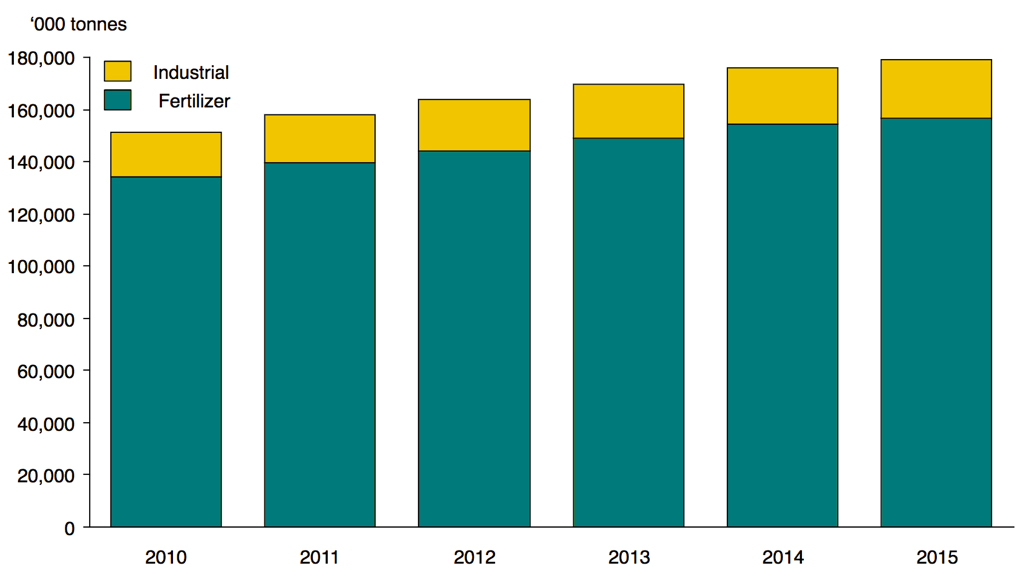Mankind is faced with the significant challenge of producing more food in the next four decades than we have over the last 10,000 years and we simply will not be able to do so without healthy soils to nourish our crops. Many solutions have been explored throughout history, ranging from organic fertilizers, synthetic alternatives and naturally occurring minerals, all of which have greatly contributed to soil nutrition. Their application was the foundation of the Green Revolution of the 1960s, which famously saved over one billion people from starvation and the practices developed continue to feed over half of the world’s population today. Without them, global food production would be halved.
Even though you may have never heard of urea, you will have certainly enjoyed its benefits. This nitrogenous chemical is the most widely used synthetic fertilizer in agriculture, with over 190 million tons produced every single year. Extremely effective, this fertilizer has become essential to maintaining an adequate supply of nutritional food. However, careful management is required because when too much urea is added to the soil, there is too much nitrogen for the plants to take in, and this nitrogen then sits in the soil, runs-off into water sources, and poisons the ecosystem. Since soil is one of our most valuable resources, containing billions of microorganisms responsible for a multitude of ecological services ranging from water regulation, filtration and cycling of nutrients to carbon sequestration, we must protect and nurture it. Healthy soil is integral to the sustainability of plant and animal life and yet we continue to add excessive amounts of synthetic chemicals into the mix. Such pervasive application has drastic impacts on our climate, human health and biodiversity. Common application methods waste more than 80% of these chemicals, leaving them free to pollute the soil for decades. One of the major risks of such fertilizer use is nitrogen run-off through aquifers and groundwater to lakes and the sea, creating blooms of algae and other organisms that deplete oxygen and generate ‘dead zones’ where nothing is able to survive.
Global Urea Consumption
 Source: International Fertilizer Industry Association (2016)
Source: International Fertilizer Industry Association (2016)
When urea is applied to the soil, water breaks the chemical down into ammonium, nitrite and nitrate (through nitrification). This process is necessary for making nitrogen, essential for plant growth and development, available to the crop. More often than not the nitrification process is too rapid, allowing significant amounts of nitrogen to escape into the atmosphere. Unfortunately, plants are able to recover only a mere fraction of this nitrogen. For urea, the Nitrogen Use Efficiency can reach a maximum of 50%. The average is closer to 30%.
This is where neem offers incredible innovation. Neem extracts decompose slowly, leading to a slower release of nutrients contained within them. When blended with urea, neem forms a fine coating and protects the loss of nutrients and minerals by ensuring regulated and continuous availability for a longer period of time, as per the requirement of the crop. This method helps plants develop more efficiently, results in higher yields and decreases environmental degradation. Neem is also cheaper than most alternative solutions and can be used as a natural pesticide, protecting crops while at the same time sustaining them.
In January of 2015, the Indian Government mandated that at least 75% of urea produced and consumed in the country would be coated with neem. Two years later and India’s food grain output will hit a record 271.98 million tons, up from 251.57 mt. Production of rice, wheat, maize, pulses and even oilseeds have reached all time highs. Urea consumption has also decreased by almost two million tons. The Agriculture Development and Rural Transformation Center in India found that the use of urea came down from 152 kg per hectare crop in 2014-15 to 149 kg in 2015-16, but the yield jumped from 2,028 kg per hectare in 2014-15 to 2,042 kg in 2015-16. This was due to neem-coated urea. Never in recent history has production of food increased when consumption of fertilizers such as urea has fallen. Neem has offered an innovative, extremely cost-effective and safe solution and will continue to prove itself as a natural, sustainable alternative for many global problems.